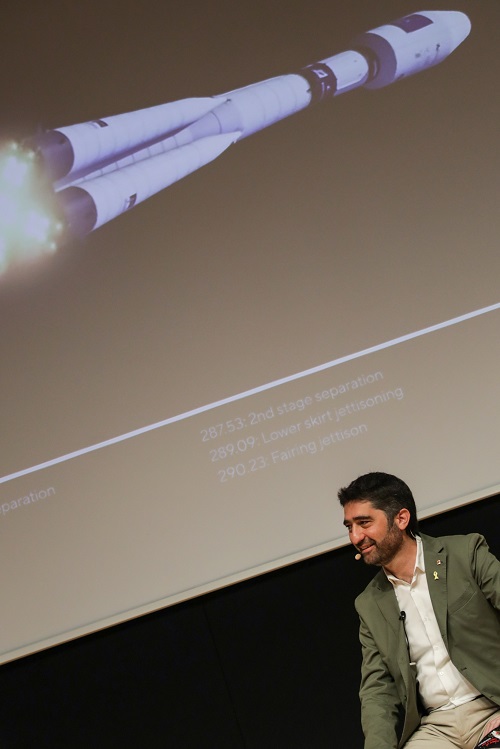- The nanosatellite, named “Enxaneta”, took off successfully today, at 07:07 am, and is already in orbit, at about 500 km from Earth
- The launch took place from the Baikonur Cosmodrome, in Kazakhstan, aboard a Soyuz 2 rocket
- This is the first of the nanosatellites that the Generalitat will put into orbit with the aim of promoting a new sector of the future full of opportunities for the Catalan economy and society
- Release images can be downloaded from the following link: https://yadi.sk/d/3B_n_0iKFqTrwQ

The first nanosatellite of the Catalan Government (Generalitat de Catalunya) is already in space. It took off today, Monday 22 March, at 7:07 (CET), from the Baikonur Cosmodrome, in Kazakhstan. The launch took place as planned, aboard a Soyuz 2 rocket, which has reached its target orbit. Unlike large geostationary satellites, which are located at an altitude of almost 36,000 kilometers, the nanosatellite is located in a low orbit, at 500 km from our planet.
Named “Enxaneta” by the children of Catalonia, this is the first of the nanosatellites that the Catalan Government will put into orbit within the framework of the NewSpace Strategy for Catalonia, a commitment to the new economy of the space as a sector for the future and job creation.
The "Enxaneta" is a 3-unit CubeSat. It is about the size of a shoe box and weighs about 10 kg. It travels at a speed of about 7 km per second and makes a full turn around the Earth every 90 minutes. It will have a calibration period of about 3 to 4 weeks before it starts giving service.
The nanosatellite will pass over Catalonia twice a day and will transmit all the collected data to the Ground Station (ground segment) located at the Montsec Observatory (OAdM), located in Sant Esteve de la Sarga, in the Pallars Jussà, and managed by the Institute of Space Studies of Catalonia (IEEC — Institut d’Estudis Espacials de Catalunya). The data will be exploited initially by the departments of the Generalitat, with the aim, later on, of opening them to universities, research centers, technology centers and companies.
The "Enxaneta", which has been developed by the companies Open Cosmos and Sateliot through a contract tendered by IEEC, will deploy global Internet of Things (IoT) connectivity services with 5G coverage. In this way, it will allow the communication and obtaining data from sensors located throughout the Catalan territory, even in areas that are difficult to access or that do not have coverage with the conventional terrestrial telecommunications networks.
This will allow, among other applications, monitoring the flow of rivers and water reserves throughout the territory — to improve and make water management more efficient —; following-up and protection of wildlife; receiving weather data from stations located in remote places; monitoring soil movements to anticipate natural disasters and surveillance livestock and crops to detect disease and define more efficient strategies.
The satellite will operate for a period of 3 or 4 years and then it will be forced to re-enter the atmosphere and disintegrate.
The take-off was followed live, from CosmoCaixa, by the Minister of Digital Policy and Public Administration, Jordi Puigneró, accompanied by the director of IEEC, Ignasi Ribas; Mariona Bádenas, a researcher at the Massachusetts Institute of Technology (MIT) and IEEC collaborator; the engineer and co-leader of Women in Aerospace Europe, Mireia Colina, and the IEEC researcher and professor at the Universitat Politècnica de Catalunya (UPC), Miquel Sureda.
The launch could be followed live and openly through the website ensposemenorbita.cat.
NewSpace, a growing economic environment
The launch of this nanosatellite is the starting point for the satellite missions of the NewSpace Strategy for Catalonia, which aims to support the deployment of this new economy of space to make Catalonia a hub of innovation, leadership and attraction of talent and companies in the field of this currently growing sector.
The Strategy has been designed to take advantage of and maximize the opportunities of a new economic area, NewSpace, based on the use of small satellites orbiting at low altitude and the exploitation of their data, with the aim of improving the services of the Generalitat and of different productive sectors.
Currently, the NewSpace ecosystem in Catalonia is made up of more than 30 emerging companies, some of them world leaders, 13 research and innovation centers, and a business incubator of the European Space Agency (ESA BIC Barcelona).
It is estimated that the development of this new high value-added economy will generate 1,200 new jobs in the next 4 years and a turnover of 280 million euros.
Released images can be downloaded from https://yadi.sk/d/3B_n_0iKFqTrwQ
The authorship of the photos must be cited: GK Launch Services.